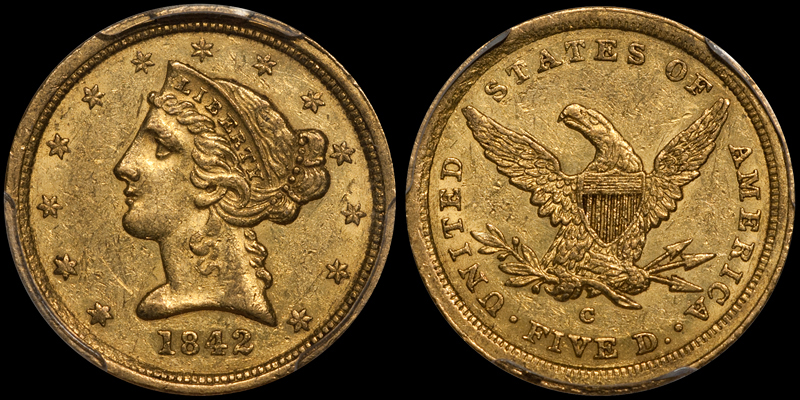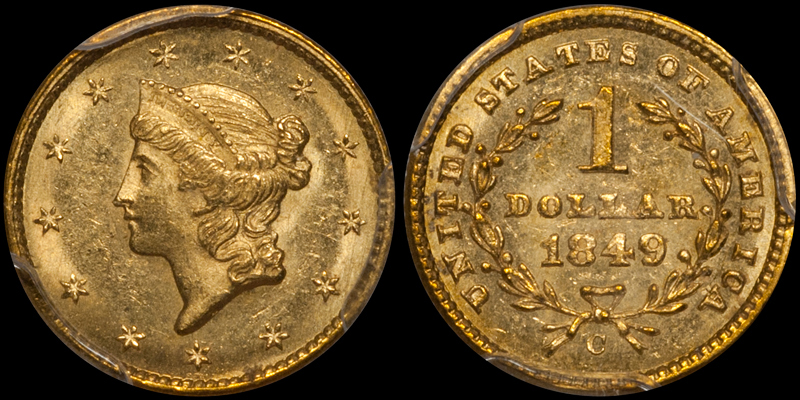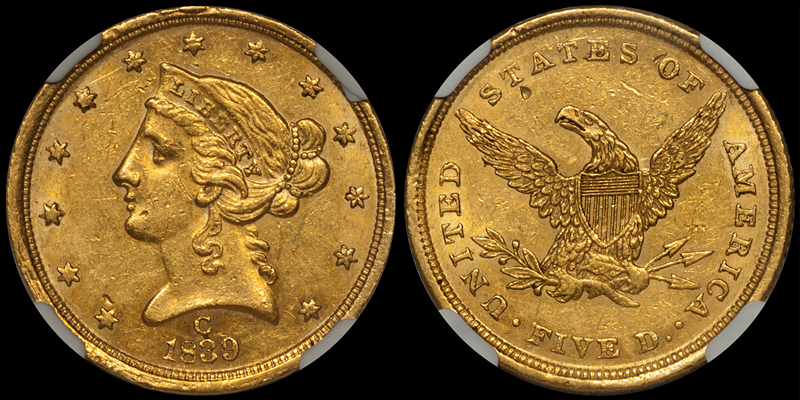So...You've Decided to Collect Charlotte Gold Coinage...
/The Charlotte mint was operational from 1838 through 1861 and it produced gold coins in three denominations only: dollars, quarter eagles, and half eagles. Today, these coins are very collectable although the number of people specializing in this mint seems to be lower than those who focus on the other two Southern facilities (Dahlonega and New Orleans).
This feels like a great point in time to specialize in Charlotte gold. There is not as much competition at the very top end of the market as there is for Dahlonega and New Orleans gold. This means that a collector wishing to focus on finest known or Condition Census issues is not necessarily biting off more than he can chew. And for those collectors whose budgets or ambitions are at a lower level, there are excellent possibilities to find nice coins in the $2,000-5,000 range.
1838-C $5.00 NGC MS60
Let’s look at collecting Charlotte coinage from a variety of perspectives.
1. Assembling a World-Class Complete Set
As I write this article (mid-March 2017), the market for very high-end Charlotte coinage is pretty thin. I have a number of clients who will avidly buy collector grade Charlotte coins, but only a few who would be interested in, say, the finest known 1851-C quarter eagle. As I mentioned above, the market is such that a new, well-heeled collector could do some pretty serious damage right now if he decided to assemble an exceptional set.
1855-C $1.00 PCGS AU50 CAC
High-grade Charlotte gold dollars are fairly plentiful for the Type One issues (1849-1853). A top-quality set could include all five of these issues in the MS62 to MS63 range, and the relatively available 1851-C can be obtained in MS64 or even MS65. The standalone Type Two 1855-C gold dollar is a very rare issue in Uncirculated and the majority of the pieces graded MS60 and MS61 are not actually “new.” The short-lived Type Three (struck only in 1857 and 1859 at this mint) is also very rare in higher grades, but appropriate coins can be located with patience.
1841-C $2.50 PCGS AU55 CAC
Quarter eagles from this mint were made in two design types: the Classic Head (1838-1839) and the Liberty Head (1840-1860). Both of the Classic Head issues exist in reasonably high grades although the 1839-C (the more common of the two) is actually very rare in nice Uncirculated. The Liberty Head issues range from scarce (1843-C Large Date, 1847-C, and 1858-C) to extremely rare (1841-C, 1842-C ,and 1843-C Small Date). I am aware of just two or three complete sets of Charlotte quarter eagles in the annals of modern collecting, but this is not an “undoable” project.
1842-C Small Date $5.00 PCGS AU55+ CAC
Charlotte half eagles exist in three design types: the Classic Head (1838), Liberty Head with Obverse Mintmark (1839), and Liberty Head with Reverse Mintmark (1840-1861). The 1838-C is the rarest Charlotte half eagle in higher grades and locating a legitimately Uncirculated example will prove next to impossible. The 1839-C exists in nice condition and all of the 1840-1861 issues can be located in Uncirculated although a few (most notably the 1842-C Small Date, 1854-C and 1861-C) are very rare to extremely rare.
I haven’t sat and added up the cost of a world-class set of Charlotte gold but I think an investment of $750,000 to $1,000,000+ would put a pretty great set together.
2. Collector Grade Sets
I would define “collector grade” as Very Fine to lower About Uncirculated when it comes to branch mint gold. As far as Charlotte coinage goes, the collector with a $2,000-5,000 budget can expect to find nice examples of nearly every single issue from this mint.
Charlotte gold dollars are for the most part affordable, and for $3,000 or so, all five of the Type One issues can be found in a nicely preserved state. The Type Two is a little more difficult to locate but it isn’t a budget-buster. The two Type Three issues didn’t circulate as extensively but they are not expensive.
1838-C $2.50 PCGS AU58 CAC
Many of the Charlotte quarter eagles can be found in nice collector grades in the $2,000-5,000 range. The dates which will likely require extra patience and/or extra cash include the 1838-C, 1842-C, and 1843-C Small Date. I highly recommend this set as it is very good value and it contains no impossible issues.
1861-C $5.00 PCGS AU58
A collector grade set of Charlotte half eagles in the $2,500-5,000 range will take some creativity. Of the 24 issues at least three or four are going to be nearly impossible to locate at this price point. But here’s a partial solution to this dilemma: the 1842-C Small Date can be eliminated by declaring the set a “year set” which makes this issue a variety (the 1842-C Large Date is far more affordable). The 1838-C and 1861-C are multiple level of demand issues which make them compelling coins to stretch for.
3. Collecting by Type
Many people who like Charlotte coinage do not aspire to assemble complete sets. For these collectors, I suggest collecting by type. Here are the major types of Charlotte gold and some basic comments on each.
Type One Gold Dollar (1849-1853). Only five issues were made and all are common. I’d suggest picking a slightly better date (1849-C Closed Wreath or 1850-C) as a type coin as it offers more bang for the buck than the common 1851-C or 1852-C.
Type Two Gold Dollar (1855 only). This standalone issue is not rare but it is poorly made and most survivors are rough and underwhelming. Study this issue before you by one and wait for a coin which you find aesthetically appealing.
Type Three Gold Dollar (1857 and 1859). Both of these dates are affordable but are difficult to locate with decent strikes and good planchets. Again, learn to judge quality before you purchase an example.
Classic Head Quarter Eagle (1838-1839). I prefer the 1838-C as a type coin due to a higher “neatness” factor as it is a first-year-of-issue. The 1839-C is more common overall but it is rarer in high grades.
Liberty Head Quarter Eagle. (1840-1860). The most common issue is the 1847-C which is well-suited for type purposes as it is well-made. I would suggest a better date as you will not have to pay a large premium to acquire a much scarcer issue.
Classic Head Half Eagle (1838). This isn’t a fabulously expensive issue but it is a really hard coin to find with original surfaces and good eye appeal. There are very few known in AU and above which are really nice, and the fantastic PCGS/CAC EF45 I recently offered for sale was ordered by over ten collectors.
Liberty Head Half Eagle Obverse Mintmark (1839). This issue was overlooked for years but it has not become popular. It is much more available in higher grades than the 1838-C but it is by no means a common coin. Be patient and wait for a nice example; one will come along.
Liberty Head Half Eagle Reverse Mintmark, Small Letters (1840-1843). This is really a sub-type but many collectors include it in their type set. I would personally select the 1840-C as the first-year-of-issue but all of these early dates are available in relatively high grades including Uncirculated.
Liberty Head Half Eagle Reverse Mintmark, Large Letters (1844-1861). This type offers the collector an opportunity to acquire a big, pretty coin for not a lot of money. The 1852-C and the 1858-C are the two most common issues in higher grades but nearly every date in this run can be bought in nice AU for $3,000-5,000.
An in-depth Charlotte type set consists of just nine coins and none are hugely expensive. A solid EF40 to AU53 collector grade assemblage can be done for around $50,000. A world-class type set with all nine coins in Uncirculated (with the likely exception of the 1838-C half eagle) could be assembled in the $200,000-250,000 range.
4. Standalone/Multiple Demand Issues
I define a “standalone” issue as a one-coin collection or an issue whose issuance has a unique quality about it. A “multiple demand” issue is one whose desirability is not confined to a specialist
The following Charlotte coins would meet my definition as standalone or multiple demand issues. An interesting collection could be built from these.
1849-C Closed Wreath $1.00 PCGS MS62 CAC
Gold Dollars:
1849-C Closed Wreath (first year of issue)
1855-C (one year type)
1839-C $2.50 NGC MS60
Quarter Eagles:
1838-C (first year of issue)
1839-C (two year Classic Head design)
1839-C $5.00 NGC MS61
Half Eagles:
1838-C (one year type)
1839-C (one year type)
1861-C (Civil War issue)
This seven coin set can be built in collector grades for under $50,000. A set consisting of world-class coins ranging from AU55/58 (for the 1838-C half eagle) to MS62/63 would cost at least $150,000-200,000.
5. Some Concluding Thoughts About Charlotte Gold
I’ve bought and sold A LOT of Charlotte coinage and I’d like to share some thoughts about what to do and what not to do when you decide to specialize in these coins..
Avoid weak mintmark 1850-C, 1853-C, and 1854-C half eagles. You’re paying a lot of money to own a Charlotte coin; shouldn’t you at least see the “C?”
Pay a premium price for a premium coin. If a seller is asking a 15% premium for an uncommonly choice 1847-C half eagle in EF45, pay up for it.
Strike is the least important factor in determining the overall eye appeal of a Charlotte coin. Learn which issues come weakly-struck and where this weakness is.
The most important factor in determining eye appeal? To me it’s a toss-up between coloration and surface preservation. Learn what color(s) each Charlotte issue is supposed to come with and also decide what kind of marks are unacceptable to you,
The best way to determine value for a Charlotte coin is by auction history. Charlotte coins trade frequently enough that APR’s for each date are fairly comprehensive and meaningful. If the last three trades for an issue are $2,500, $2,800 and $3,200 you can determine that a coin you are interested in is worth somewhere in the $2,500 to $3,200 range.
Collector-quality Charlotte coins have performed relatively well in the last decade while the world-class coins have stayed fairly stagnant during this period. This is a result of gradeflation (AU coins morphing into Uncirculated coins) as much as it is a lack of collector interest at the top end of the market.
So there you have it: a basic guide to collecting Charlotte gold. I have a strong fondness for these coins and I think at current levels they are underappreciated. Remember: a small tick upwards in demand will have a significant impact on the supply of nice coins; be they VF35 1855-C half eagles or MS64 1851-C gold dollars.
Are you interested in assembling a meaningful collection of Charlotte coins in either collector grades or at the Condition Census level? If so, I’d love to work with you and can be reached via email at dwn@ont.com.


















